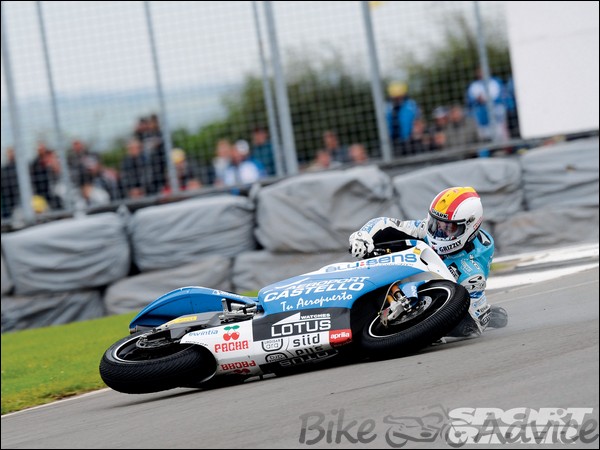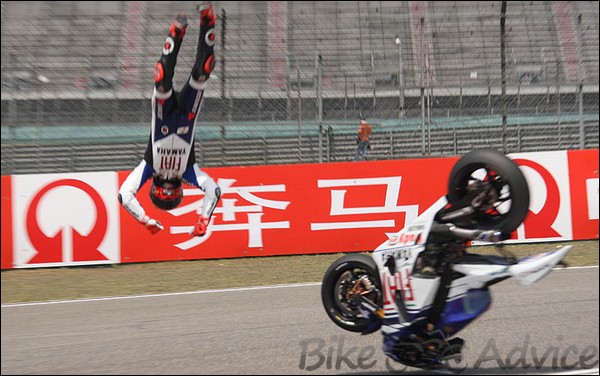Prevention is always better than cure. Here we are talking about prevention of disaster while riding. Safety gears and riding awareness always help us to limit most of the accidents. Sometimes, circumstances arise in which we can’t do anything. Everything goes wrong and we have to suffer through an accident. Nevertheless we can reduce fatal injuries to ourselves and damages to our bikes.

Let us first briefly discuss the forces acting on the bike at the time of turning. There are mainly four forces acting on the bike + rider system. Two of them act at CG point and rest two act at the tyre contact patches. Check image above…
- Fw is the downward force and acts at CG point. This force is a result of weight of the rider + bike system. No doubt, line of action of this force totally depends on the ability of the rider. This line of action enormously affects the stability of the bike at the time of turning.
- Fc is another horizontal force that acts at CG point. For simplicity, gyroscopic forces and restoring forces of each wheel are included in Fc only. Fc is a centrifugal force that gets generated when any mass rotates. Rider + bike system also acts as a rotating mass with respect to imaginary centre of turning radius. The amount of Fc purely depends on the square of the speed of the vehicle at the time of turning.
- Next is the traction force exerts at contact patch of the rear tyre. It is worthless to mention that the traction force results in forward motion of the system.
- Last force is the friction force or we can say “grip” generated at the contact patches of both the tyres.
A perfect turn at some speed is nothing but a neutralization of these four forces. We always are making equilibrium between these forces at the time of turning either consciously or unconsciously. Any of the unbalanced or uncontrolled force leads to disaster. Let us have some idea about different types of accidents that could be possible with two wheelers.
Low Side
It is most common type of accident and also the safest one ( though it seems funny to mention any accident as “safe”). This ranges from the rather insignificant and obvious case that a stationary motorcycle simply falls over unless held upright. In moving condition, it is the slow speed case where the bike starts to turn and lean to one side in a gradual reduction in curve until it falls over also.
It is the result of lack of centrifugal force Fc. That means, bike has been tilted more than required at particular speed. This increases the downward force Fw and results in a fall. Low side can also be result of losing grip at high speeds if the grip doesn’t resume.

In the case of low side type accident rider and bike both skid on the road surface. The rider always follows the bike at the time of skidding and that’s why it is called “low side”. Low side has been defined with respect to the rider’s position. Obviously at the time of skidding, the rider can observe the flipping or skidding of his bike and can control his motion afterwards to avoid major injuries.
As bike also skids, only one side of the bike gets damaged. In very few cases, especially at high speeds, skidding of the bike is converted in to flip and damages are higher.
High Side
Apart from the forces at CG point, high-side is a classic theory of “slip and flip“, more to the point it is a tyre grip issue. The standard explanation is that the tyre slips and then just grips again, throwing the bike and rider over the top. That is why it is called “High side”. Inverse to the low side, bike always follows the rider after the high side instant. Moreover, bike mostly flips terrifically after high side and damages are more.

When the rider overdoes the throttle, total tyre grip is reduced and the bike starts to slide. To avoid this sliding, the rider is likely to shut the throttle and apply brakes, thus removing the traction force from the tyre and making available the grip again. As the bike gets more grip than required (because speed has been already decreased by shutting throttle and applying brakes), it tries to straighten up vertically towards normal position. This sudden movement of the bike produces jerk and the rider loses his handle grip. This movement also forces to throw the driver ahead of bike.
Wobble (Shimmy)
Wobble takes place if – when the front wheel is displaced by some road irregularity or sudden hard braking, the restoring torque created by the steering geometry happens to be strong enough to over-correct for the initial disturbance. The wheel then swings beyond the straight-ahead position and steer in the opposite direction. This in turn creates another but opposite restoring force, which repeats the whole process, and we have a side-to-side steering wobble caused by the bike’s steering geometry. The above is a simplified explanation of a phenomenon known as harmonic motion which we can observe in simple pendulum.
This instability occurs mostly at high speed. This high speed is in accordance to the mass of the rider + bike system that means speed of 40-50 kmph can also generate wobble if mass is very less. As wobble is an oscillation of the front steered mass about the steering axis, weave is considered as an oscillation of the rear steered mass (the main part of the bike and rider) about the steering axis. It is a much more complex form of instability, because there is a lot more cross coupling between the various degrees of freedom of possible motions. Mostly in practice, wobble is the combination of oscillation of front and rear masses simultaneously.
Wobble or shimmy can be easily remedied by adjusting speed, position, or grip on the handlebar; it can be fatal if left uncontrolled. It is not at all possible to predict the motion and path of the rider + bike after accident. This always leads to major damages.
9 Basic Pointers Which Will Help You SAVE FUEL
Front and Side Collision
Obviously none of the engineering terms work behind these disasters. They are just because of misconstruation of one or more riders. These types of accidents mostly convert into deadly crashes because bikes don’t contain any crumple zones. Only frames are designed to absorb the shocks and they easily get smashed under extreme loading.
Here again, I want to state that prevention is better than cure. It is always safe to avoid uncontrolled motions like high side, wobble, weave and collisions by converting them in to low side kind accidents. Let us now draw our attention to some points about how we can convert any uncontrolled motion in to low side type motion.
- Quickly calculate approx distance between you and the obstacle. Even more rapidly, guess the stopping distance of your bike.
- If the distance available is less than the required, try to generate ABS type action in your normal bike. Apply the rear brake instantly and hold it. At the same time, apply the front brake two or three times to generate ABS kind effect. This will help to stop the bike within short distance. Please keep in mind, all these operations must be performed in almost vertical position.
- This will affect inversely and will generate high side or wobble if these operations are performed at an inclined position.
- If you don’t have any other options than a collision, quickly get the idea about the surroundings. i.e. moving vehicles on right side and behind you, stationary vehicles on left side, stationary obstacles on left side, bed of sand/clay/mud on the road etc.
- Try to change the direction by tilting your bike to avoid front collision.
- If distance available to stop the bike is too small, tilt your bike slightly and brake hard. This generates skid and gets converted in to low side.
- Never release throttle too much or brake too hard while skidding starts. This will lead to high side.
- Never increase throttle or release brakes while skidding starts. This will lead to wobble.
- Always try to crash on the bed of sand/clay/mud if it is there. It will absorb the kinetic energy and reduce the damage.
- Second preference should be given to the stationary stuffs because they don’t contain any energy. Your kinetic energy will be transferred to it and will reduce damage.
- Avoid collision with moving things because they possess their own kinetic energy. Resultant force and direction of resultant motion always remain uncontrolled after collision.
- Release your bike after starting the skid. This will help to reduce injuries. The terrific impact energy is transferred to your body if you hold your bike till collision.
- If you fail to avoid high side or wobble, try to keep your eyes on your bike. There is possibility that your own bike may smash you hard in these cases.
I know that the mentioned “Quickly” in above points is not an easy job at the time of disaster. I again want to advice you all to ride safe: Safe for yourself as well as for others. Keep your attention on RVMs as well as opposite lane at the crossings.
Motorcycle Manufacturing: What Happens Before a Bike Reaches YOU
I hope this post will help you all to understand the basics of unintentional parameters that are responsible for accidents. This article is written by referring “Motorcycle Handling and Chassis Design – The Art and Science” by Tony Foale.
– Dhruv Panchal


